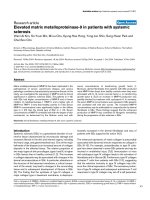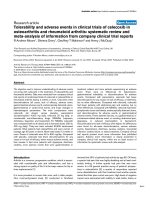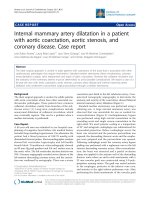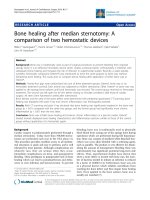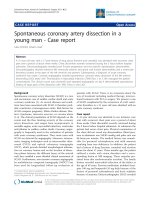Báo cáo y học: "Reporting Iraqi civilian fatalities in a time of war" doc
Bạn đang xem bản rút gọn của tài liệu. Xem và tải ngay bản đầy đủ của tài liệu tại đây (395.05 KB, 7 trang )
BioMed Central
Page 1 of 7
(page number not for citation purposes)
Conflict and Health
Open Access
Research
Reporting Iraqi civilian fatalities in a time of war
Schuyler W Henderson
1
, William E Olander
2
and Les Roberts*
3
Address:
1
Department of Psychiatry, Columbia University, New York, New York, USA,
2
Mailman School of Public Health, Columbia University,
New York, New York, USA and
3
Department of Population and Family Health, Columbia University, New York, New York, USA
Email: Schuyler W Henderson - ; William E Olander - ; Les Roberts* -
* Corresponding author
Abstract
Background: In February, 2007, the Associated Press (AP) conducted a poll of 1,002 adults in the
United States about their attitudes towards the war in Iraq. Respondents were remarkably accurate
estimating the current death toll of US soldiers, yet were grossly inaccurate in estimating the
current death toll of Iraqi civilians. We conducted a search of newspapers reports to determine
the extent of the discrepancy between reporting Coalition and Iraqi civilian deaths, hypothesizing
that there would be an over-representation of Coalition deaths compared to Iraqi civilian deaths.
Methods: We examined 11 U.S. newspapers and 5 non-U.S. newspapers using electronic
databases or newspaper web-archives, to record any reports between March 2003 and March 2008
of Coalition and Iraqi deaths that included a numeric indicator. Reports were described as "events"
where they described a specific occurrence involving fatalities and "tallies" when they mentioned
the number of deaths over a period of time. We recorded the number of events and tallies related
to Coalition deaths, Iraqi civilian deaths, and Iraqi combatant deaths
Results: U.S. newspapers report more events and tallies related to Coalition deaths than Iraqi
civilian deaths, although there are substantially different proportions amongst the different U.S.
newspapers. In four of the five non-US newspapers, the pattern was reversed.
Conclusion: This difference in reporting trends may partly explain the discrepancy in how well
people are informed about U.S. and Iraqi civilian fatalities in Iraq. Furthermore, this calls into
question the role of the media in reporting and sustaining armed conflict, and the extent to which
newspaper and other media reports can be used as data to assess fatalities or trends in the time of
war.
Background
In February, 2007, the Associated Press (AP) conducted a
poll of 1,002 adults in the United States about their atti-
tudes towards the war in Iraq [1]. Respondents were asked
to estimate the number of US soldiers and Iraqis who had
died in the war. The median estimate for US soldiers was
2,974 while the actual toll at the time was 3,100 [2]. In
contrast, when asked to estimate the number of Iraqi civil-
ian casualties, the median answer was 9,890 at a time
when it was at least 10 times this number, with some esti-
mates putting the toll at 50 times this number [3,4]. The
U.N. Assistance Mission for Iraq, for example, tallied
more than 34,000 deaths in 2006 alone [5].
This poll suggests that Americans were remarkably accu-
rate in estimating the numbers of US military who had
Published: 6 November 2009
Conflict and Health 2009, 3:9 doi:10.1186/1752-1505-3-9
Received: 18 May 2009
Accepted: 6 November 2009
This article is available from: />© 2009 Henderson et al; licensee BioMed Central Ltd.
This is an Open Access article distributed under the terms of the Creative Commons Attribution License ( />),
which permits unrestricted use, distribution, and reproduction in any medium, provided the original work is properly cited.
Conflict and Health 2009, 3:9 />Page 2 of 7
(page number not for citation purposes)
died but were inaccurate in estimating the numbers of Ira-
qis who had died. We conducted a search of newspapers
to determine the extent of the discrepancy between report-
ing Coalition and Iraqi civilian deaths (see appendix 1 for
examples), hypothesizing that there would be an over-
representation of Coalition deaths compared to Iraqi
civilian deaths, reflecting the discrepancy in broader pub-
lic opinion. This paper reports the relative numbers of
articles describing Coalition deaths and Iraqi deaths for
11 US papers, and five non-US newspapers.
Methods
Newspapers were selected by having each participant
review their hometown newspaper. Five non-US newspa-
pers were also selected: one (The Guardian) was selected as
a hometown paper. A second contributor picked a mid-
dle-eastern paper because his home town (NYC) was
already taken. The results were so dramatically different
that others were sought: they constituted all of the Middle
East newspapers we could find that were free, online, and
had a full text search mechanism such as ProQuest. By
reviewing the group's hometown newspaper, we exam-
ined a geographically diverse selection of US newspapers:
San Francisco Chronicle, New York Daily News, Columbus
Dispatch, Christian Science Monitor, Pittsburgh Post-Gazette,
Los Angeles Times, Dayton Daily, San Antonio Express, Boston
Globe, Bergen Record, and Washington Times (n = 11), as
well as five non-US newspapers: the Lebanon Daily Star,
Gulf News, Turkish Daily News, Al-Bawaba and The Guard-
ian (n = 5).
For each month between the start of the second Gulf War
(March, 2003) and March, 2008, using the search lan-
guage IRAQ and KILL* or IRAQ and DEATH* in either Pro-
Quest or Factiva databases, we recorded how often each
newspaper reported death events and/or overall death tal-
lies in the body of text. For a couple of newspapers with
their own web archives, we used the same search method-
ology. This search procedure would result in a list of arti-
cles with either Iraq and any word beginning with "kill" or
Iraq and any word beginning with "death", or both. We
defined an "event" as any description of a violent death
and defined a "tally" as any description of a death toll in
a time period. We further classified these events or tallies
as "Coalition", "Iraqi Civilian", "Combatant" or "Other"
(for vague/ambiguous descriptions). Many articles
included both events and tallies and thus could have been
recorded in multiple categories. For example, a report that
mentioned the death of a coalition soldier and added that
this raised the death toll for coalition soldiers that week to
ten would count as both an event and a tally. While these
terms may not catch every article of interest, it was felt that
using consistent terms would still provide an accurate
measure of the relative numbers of Coalition vs. Iraqi
death events and tallies.
Participants were asked to record the number of four
kinds of articles that occurred in their hometown paper
between March 2003 and March of 2008: those that
described at least one event where a Coalition member
was killed, those that described at least one event where
an Iraqi was killed (further divided into Combatant and
Civilian), articles that provided a tally of Coalition deaths
for some time period, and articles that provided a tally of
Iraqi deaths for some time period. While we agreed on
broad definitions such as all police and non-military gov-
ernment employees would be called civilians, difficult
judgment calls (e.g. military recruits that were killed but
were not yet in the employ of the military) were left up to
the judgment of the reviewer. It was felt that by having
people raised in the various towns of the newspapers,
reading and judging the reports with a local perspective,
we would get the closest reflection of the experience of
those papers' readers.
If an event was reported more than once in the same
newspaper, we counted it every time it was reported, so
long as it was in a separate article. If a single soldier's
death was reported numerous times, we counted each
time individually (for example, if a soldier's death was
mentioned in a news report, an obituary, and an editorial,
it was counted three times).
For death events, the sum of the articles seen in each
month was tallied among the US and Middle-Eastern
newspapers. While this may have the effect of over-influ-
encing the results by the papers with the most death event
articles (e.g. the Los Angeles Times), these papers tended to
have the largest readership and thus we believe the sum-
mation is somewhat self-correcting in terms of nation-
wide reader experience.
Results
Events
The five year review of 11 US newspapers produced 7,151
articles describing Coalition deaths, 4,445 articles describ-
ing Iraqi Civilian deaths. The 4 Middle-Eastern Newspa-
pers produced 495 articles describing Coalition deaths,
and 923 articles describing Iraqi Civilian deaths. The sum-
mation of the number of Coalition and Iraqi Civilian
death events is presented in the figures below, first for 11
US newspapers, and second for 4 Middle-Eastern Newspa-
pers (Figure 1 and Figure 2).
Tallies
The five year review of 11 US newspapers produced 4,701
articles describing Coalition death tallies and 1,972 arti-
cles describing Iraqi Civilian death tallies. The 4 Middle-
Eastern newspapers produced 109 articles describing Coa-
lition death tallies and 112 articles describing Iraqi Civil-
ian death tallies. The summation of the number of
Conflict and Health 2009, 3:9 />Page 3 of 7
(page number not for citation purposes)
Coalition and Iraqi Civilian death tallies is presented in
the figures below, first for 11 US newspapers, and second
for 4 Middle-Eastern Newspapers (Figure 3 and Figure 4).
Ratios
Figures 5 and 6 show the ratios of Coalition to Iraqi civil-
ian death articles in the studied newspapers (Figure 5 and
Figure 6).
Discussion
How the media chooses to report the numbers of dead
and dying in Iraq may play a role in shaping the public's
knowledge about the consequences of the war. The AP
poll showed that respondents were substantially more
accurate in identifying the number of Americans who had
died as a result of the Iraq war than Iraqis. There are sev-
eral striking findings in our study. First, by even the most
conservative estimates, at least 20 times as many Iraqis
have died as Coalition members, but in virtually all Amer-
ican papers there are far more articles describing coalition
death events and tallies. Second, this relationship was
reversed for three of the four Middle-Eastern papers and
the one British paper included. Third, there are substantial
differences between U.S. newspapers.
To the best of our knowledge, there is no other study that
has quantified how the media has represented deaths in
the time of war, or compared US newspapers to newspa-
pers in the Middle East. The discrepancies we have
observed should encourage further study into how media
representation affects public knowledge, attitudes towards
wars, and public debates about the consequences of a war.
Number of articles per month reporting Coalition and Iraqi civilian deaths in 11 US newspapersFigure 1
Number of articles per month reporting Coalition and Iraqi civilian deaths in 11 US newspapers.
Number of articles per month reporting Coalition and Iraqi civilian deaths in four Middle-east newspapersFigure 2
Number of articles per month reporting Coalition and Iraqi civilian deaths in four Middle-east newspapers.
Conflict and Health 2009, 3:9 />Page 4 of 7
(page number not for citation purposes)
Our study cannot and does not explain how or why there
is a variance in reporting and nor does it measure accuracy
per se. Certainly all newspapers can only report some frac-
tion of killings in a country as vast and violent as Iraq. But
specific factors seem to be influencing the level and the
relative reporting of victims from the different nationali-
ties involved. These factors may include: local interests;
local sensitivities, such as residents who have lost rela-
tives; wire service affiliations; access to embedded journal-
ist reports; the economic and political agendas of the
various editorial boards, and other political pressures.
This study poses a challenge to journalism. Mark Twain
once said to a class of Army cadets, "By the etiquette of
war, it is permitted to no one below the rank of newspaper
correspondent to dictate to the general in the field." [6]
While his joke suggests that journalists tend to assume an
expertise they may not deserve, there is an important
point contained therein: in a democracy, the military
operates on behalf of the people, who in turn are in a large
part informed by their media outlets. Journalists risk their
lives to report on wars and face numerous ethical chal-
lenges - from the ethics of what to report to the practicali-
ties of being embedded. However, despite what individual
journalists may achieve, there can be an overall effect
from the media as a whole, and our study appears to show
that Americans will likely be exposed to one story (of
American fatalities) with much less information about
another story (of Iraqi fatalities). Given the discrepancy
between the U.S. and the non-U.S. newspapers, it would
appear that political and cultural factors may be playing a
role in how these stories are being told.
This study has a number of significant limitations. We
cannot assume that media reports of death events/tallies
correlates with overall knowledge, especially if people
Number of articles per month reporting Coalition and Iraqi civilian death tallies in 11 US newspapersFigure 3
Number of articles per month reporting Coalition and Iraqi civilian death tallies in 11 US newspapers.
Number of articles per month reporting Coalition and Iraqi civilian death tallies in four Middle-east newspapersFigure 4
Number of articles per month reporting Coalition and Iraqi civilian death tallies in four Middle-east newspa-
pers.
Conflict and Health 2009, 3:9 />Page 5 of 7
(page number not for citation purposes)
obtain their news from numerous sources. Respondents
do not only get their news from newspapers. At about the
same time as the AP poll was conducted, Harris Interactive
conducted a poll in which they asked about how Ameri-
cans get their news [7]. The vast majority (77%) said they
watch local broadcast news and 71% said they watched
network broadcasts or cable news several times a week or
daily. 63% reported reading a local daily newspaper and
18% read a national newspaper several times a week or
daily. 64% go online to get news (which may be from
newspapers online). Thus, a limitation of our study is a
focus on newspapers, rather than broadcast news, and our
exclusion of national newspapers such as Herald Tribune
or USA Today. A review of TV and radio reports would be
far less easily quantified because length of segments varies
widely and visual images of killed or injured may be far
more memorable or exert more influence.
In terms of study design, this study involved a number of
participants each tallying scores from a newspaper; this
Ratio of articles reporting Coalition deaths to Iraqi civilian deaths in examined papers, March 2003 - March 2008Figure 5
Ratio of articles reporting Coalition deaths to Iraqi civilian deaths in examined papers, March 2003 - March
2008.
Ratio of articles reporting Coalition death tallies to Iraqi civilian death tallies in examined papers, March 2003 - March 2008Figure 6
Ratio of articles reporting Coalition death tallies to Iraqi civilian death tallies in examined papers, March 2003
- March 2008.
Conflict and Health 2009, 3:9 />Page 6 of 7
(page number not for citation purposes)
required individual judgment as to what constituted an
"event" and a "tally"; discussions amongst the partici-
pants, usually over possibly ambiguous reports, suggested
that although this remains a limitation, the reliability and
validity of these terms was high with little variation
between reviewers. Furthermore, while it is not typical of
study designs to have a flexible set of "definitions", we feel
this review method captures the at-home readers' experi-
ence more robustly and best interprets the narrative com-
ponent of war reporting.
While we believe our search methods capture a majority
of the articles written about deaths in the Iraqi war, our
search language did not include every mention of the war.
It excludes non-specific, general remarks such as "the civil-
ian death toll is rising". We explored many different
search terms initially and these two pairs gave us a com-
paratively high number of hits with a low fraction of arti-
cles with no events or tallies. Of note, we were not
expecting to capture every article, just the vast majority
with a consistent process that could detect trends over
time and between papers. Finally, it is worth remember-
ing that other means of communicating in the newspaper,
including editorials and photographs, may be discussing
or evoking the war compellingly but without the numeric
indicators that would place them within our study.
Conclusion
The initial AP poll reported that a substantial number of
the respondents - 17% - knew someone who had been
injured or killed in the war and 65% knew someone per-
sonally who was currently or had previously served in the
war [2]. It is expected that many Americans have a per-
sonal investment in the war and so may have been more
attuned to statistics about the war pertaining to U.S. mili-
tary. As papers reflect the interests of their readers, it is not
surprising that U.S. newspapers describe more events and
tallies related to Coalition deaths than Iraqi civilians. Nev-
ertheless, it is somewhat inconsistent with the goals of
journalism that among violent deaths in Iraq, it appears
more likely an event will be reported in U.S. newspapers
if the decedent is an American. We feel that this study casts
an important light on the role of the media in represent-
ing war, and may explain in part why Americans are so
well informed about Coalition deaths and relatively igno-
rant about Iraqi deaths. This paper calls into question the
extent to which the media plays a role in promoting and
sustaining armed conflict, and even whether or how the
media can be a tool for civilian check on military action
or complicit in ongoing warfare [8].
Finally, this work poses a significant challenge to those
databases, including the Iraq Body Count http://
www.iraqbodycount.org. and the Uppsala Conflict Data
Set />, that
assess conditions and fatalities based on media reports.
Newspaper data is not impartial or proven and our study
strongly suggests that there are contextual, including pos-
sibly cultural and political, factors that profoundly affect
what and how data regarding fatalities in the Iraq War are
being presented.
Competing interests
The authors declare that they have no competing interests.
Authors' contributions
LFR proposed the review and supervised data collection.
SWH wrote much of the initial results and collected data.
WEO prepared the figures and collected data. All authors
read and approved the manuscript.
Appendix 1
The following are two examples of our search rules:
In an article from the New York Daily News on July 7,
2007: "A suicide bomber killed more than 100 people by deto-
nating a truck bomb in the center of an Iraq market yesterday,
police said. The killings pushed the death toll in the last three
days to more than 140 people - including eight U.S. soldiers.
Local police said the bombing close to Tuz Khurmatu, north of
Baghdad, killed 105 and left more than 250 wounded "
Under our search rules, we would record this article as one
"Coalition" death incident article and one "Iraqi Civilian"
incident article. Because this tally did not cover a specific
month, week or year, it was not recorded as a tally.
In an article from the New York Daily News on May 19,
2007: "After a week with the anguish of not knowing whether
their sons were alive or dead, four families of troops from New
York's 10th Mountain Division learned yesterday which of
them can still hold on to hope in Iraq yesterday, five more
U.S. troops were killed, three by a roadside bomb northeast of
Baghdad. Two others were killed and nine wounded in separate
attacks in southern sectors of the capital. The latest casualties
brought the U.S. death toll for May to at least 58, and to 3,408
since March 2003 " Under our search rules, we would
record this article as one "Coalition" death incident article
and one "Coalition" death tally article.
Acknowledgements
Thanks to the following individuals who reviewed their hometown newspa-
per: Saundra Ball, Lucy Anderson, Sandy Do, Elijah Kim, Michelle Kim, Ail-
een Langston, Faith McCollister, Sawsan Metry, Braeden Rogers, Saroj
Sedalia, Katherine Slawsky, Deborah Tsuchida, Joan VanWassenhove, Cairn
Verhulst, Justina Wu.
References
1. The Free Library. Methods Behind the AP-Ipsos Poll 2007
[ />Ipsos+poll+on+Iraq-a01611334158].
Publish with Bio Med Central and every
scientist can read your work free of charge
"BioMed Central will be the most significant development for
disseminating the results of biomedical research in our lifetime."
Sir Paul Nurse, Cancer Research UK
Your research papers will be:
available free of charge to the entire biomedical community
peer reviewed and published immediately upon acceptance
cited in PubMed and archived on PubMed Central
yours — you keep the copyright
Submit your manuscript here:
/>BioMedcentral
Conflict and Health 2009, 3:9 />Page 7 of 7
(page number not for citation purposes)
2. Associated Press. Index of US Troop Deaths in Iraq. USA
Today 2008 [ />alties.htm].
3. Tapp C, Burkle FM, Wilson K, Takaro T, Guyatt GH, Amad H, Mills
EJ: Iraq War mortality estimates: A systematic review. Con-
flict and Health 2008, 2:1.
4. Burnham G, Lafta R, Doocy D, Roberts L: Mortality after the 2003
invasion of Iraq, across-sectional cluster sample survey. Lan-
cet 2006, 368:1421-28.
5. Benac, N Americans Underestimate Iraqi Death Toll 2007
[ />ap-poll/].
6. Twain, Mark The Complete Essays of Mark Twain. Doubleday
Company Inc: New Jersey; 1963.
7. Harris Online. Seven in 10 U.S. Adults Say They Watch
Broadcast News at Least Several Times a Week [http://
www.harrisinteractive.com/harris_poll/index.asp?PID=644]
8. Jamail, D Covering up the Trail of Dead Iraqis Salon.com 2007
[ />iraq_civilian_deaths/].


